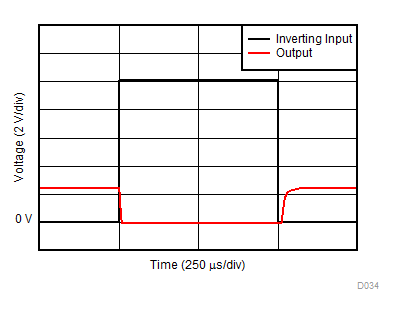at TA = 25°C,
VSENSE = VIN+ – VIN-, VS = 1.8 V to
5.0 V, VIN+ = 12 V, VREF = VS / 2,
VENABLE = VS, and for all gain options
(unless otherwise noted)
 Figure 6-1 Gain
vs. Frequency
Figure 6-1 Gain
vs. Frequency Figure 6-3 Common-Mode Rejection Ratio vs. Frequency
Figure 6-3 Common-Mode Rejection Ratio vs. Frequency Figure 6-5 Output Voltage Swing vs. Output Current
Figure 6-5 Output Voltage Swing vs. Output Current Figure 6-7 Input
Bias Current vs. Common-Mode Voltage (Shutdown)
Figure 6-7 Input
Bias Current vs. Common-Mode Voltage (Shutdown) Figure 6-9 Quiescent Current vs. Temperature (Disabled)
Figure 6-9 Quiescent Current vs. Temperature (Disabled) Figure 6-11 Input-Referred Voltage Noise vs. Frequency
Figure 6-11 Input-Referred Voltage Noise vs. Frequency Figure 6-13 Step
Response (10-mVPP Input Step)
Figure 6-13 Step
Response (10-mVPP Input Step) Figure 6-15 Inverting Differential Input Overload
Figure 6-15 Inverting Differential Input Overload Figure 6-17 Start-Up Response
Figure 6-17 Start-Up Response Figure 6-19 Enable and Disable Response
Figure 6-19 Enable and Disable Response
| VS = 5.0 V, VREF = 2.5 V, A2,
A3, A4, A5 devices |
Figure 6-21 IB+
and IB– vs. Differential Input Voltage
| VS = 5.0 V, VENABLE = 0 V,
VREF = 2.5 V |
Figure 6-23 Output Leakage vs. Output Voltage (A4 and A5 Devices) Figure 6-2 Power-Supply Rejection Ratio vs. Frequency
Figure 6-2 Power-Supply Rejection Ratio vs. Frequency Figure 6-4 Output Voltage Swing vs. Output Current
Figure 6-4 Output Voltage Swing vs. Output Current Figure 6-6 Input
Bias Current vs. Common-Mode Voltage
Figure 6-6 Input
Bias Current vs. Common-Mode Voltage Figure 6-8 Quiescent Current vs. Temperature (Enabled)
Figure 6-8 Quiescent Current vs. Temperature (Enabled) Figure 6-10 Quiescent Current vs. Common-Mode Voltage
Figure 6-10 Quiescent Current vs. Common-Mode Voltage Figure 6-12 0.1-Hz to 10-Hz Voltage Noise (Referred-To-Input)
Figure 6-12 0.1-Hz to 10-Hz Voltage Noise (Referred-To-Input) Figure 6-14 Common-Mode Voltage Transient Response
Figure 6-14 Common-Mode Voltage Transient Response Figure 6-16 Noninverting Differential Input Overload
Figure 6-16 Noninverting Differential Input Overload Figure 6-18 Brownout Recovery
Figure 6-18 Brownout Recovery
| VS = 5.0 V, VREF = 2.5 V, A1
devices |
Figure 6-20 IB+
and IB– vs. Differential Input Voltage
| VS = 5.0 V, VENABLE = 0 V,
VREF = 2.5 V |
Figure 6-22 Output Leakage vs. Output Voltage (A1, A2, and A3 Devices) Figure 6-24 Output Impedance vs. Frequency
Figure 6-24 Output Impedance vs. Frequency















 Figure 6-8 Quiescent Current vs. Temperature (Enabled)
Figure 6-8 Quiescent Current vs. Temperature (Enabled)






